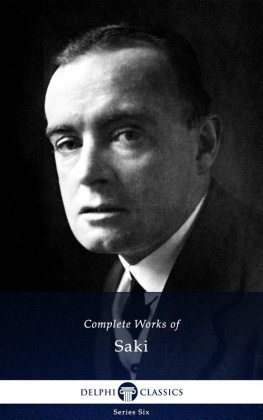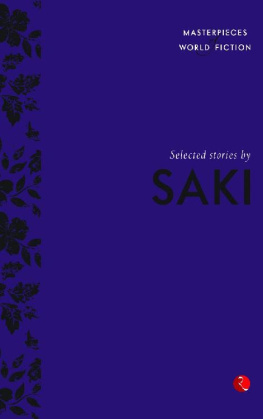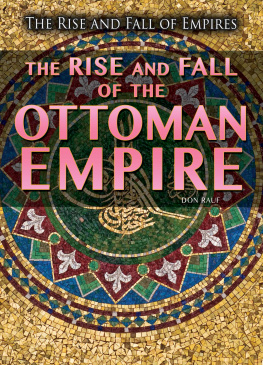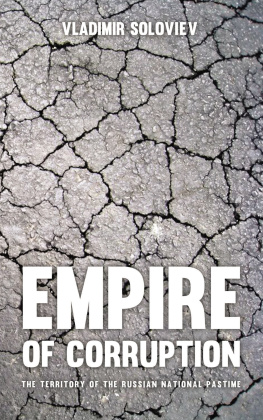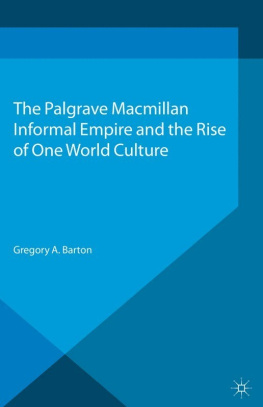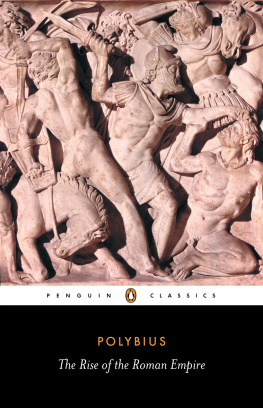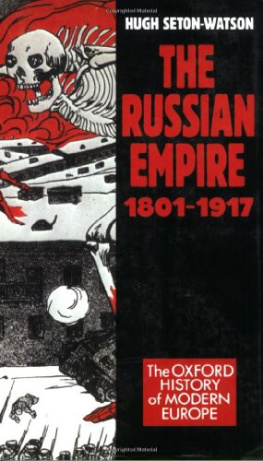The cover image was produced by the transcriber using an image from the book, and is placed in the public domain.
Illustrations with borders are linked to higher-resolution images.
THE RISE OF THE RUSSIAN EMPIRE
PUBLISHERS ANNOUNCEMENT
Demy 8vo, Cloth, 25s.
With two coloured maps and ten specially drawn
RUSSIA IN ASIA
A RECORD AND A STUDY
1558-1899
BY
ALEXIS KRAUSSE
Author of China in Decay
Spectator. It is well that the vague alarm generally inspired in the average Englishman by the thought of Russian successes in Asia should be replaced by exact knowledge. Books without number have already been written upon the several phases of the Russian advance, but Mr. Krausses volume is, we think, the first concise presentation in English of its entire history.
London: GRANT RICHARDS
9 Henrietta St., Covent Garden, W.C.
MAP OF
RUSSIA
under the
EARLY RURIKOVITCH PRINCES
THE RISE
OF
THE RUSSIAN EMPIRE
BY
HECTOR H. MUNRO
On se flatterait en vain de connaitre la Russie actuelle, si lon ne
remontait plus haut dans son histoire. Le Pre Pierling.
LONDON
GRANT RICHARDS
1900
PREFACE
With the exception of a translation of Rambauds somewhat disjointed work, there is no detailed history of Russia in the English language at all approaching modern standards. The reigns of Petr the Great and of some of his successors down to the present daya period covering only 200 yearshave been minutely dealt with, but the earlier history of a nation with whom we are coming ever closer into contact is to the English reader almost a blank. Whether the work now submitted will adequately fill the gap remains to be seen; such is its object.
The rule observed with regard to the rendering of names of places and persons has been to follow the spelling of the country to which they belong as closely as possible. The spelling of Russian words employed, and curiously distorted, by English and other historians, has been brought back to its native forms. There is no satisfactory reason, for instance, why the two final letters of boyarin should be dropped, or why they should reappear tacked on to the equally Russian word Kreml. Moskva is scarcely recognisable in its Anglicised form, and Kiev can only be rendered Kieff on a system which would radically disturb the spelling of most English towns.
A list of works consulted is appended, arranged somewhat in the order in which they have been found useful, precedence being given to those which have been most largely drawn upon.
HECTOR H. MUNRO,
1899.
WORKS CONSULTED
Karamzin Histoire de lempire russe. 1819. (French translation by MM. St. Thomas et de Divoff.)
S. Solovev Istoriya Rossie. 1858.
Th. Schiemann Russland, Polen und Livland. 1885.
A. Rambaud History of Russia. 1879. (English translation.)
L. Paris (translator)Chronique de Nestor. 1834.
N. Kostomarov Rousskaya Istoriya v jhizneopisaniyakh eya glavnieyshikh dieyatelen. 1874.
N. Kostomarov Sieverno Rousskiya Narodopravstva. 1886.
Sir H. H. Howorth History of the Mongols.
Anonymous Geschichte der Ostseeprovinzen. 1879.
Von Hammer-Purgstall Geschichte der goldenen Horde. 1840.
Histoire de lEmpire Ottoman. (French translation.)
E. A. Freeman Ottoman Power in Europe. 1877.
J. W. Zinkeisen Geschichte des osmanischen Reich in Europa.
Gennad Karpov Istoriya Borbui Moskovskago Gosoudarstvo s Polsko-Litovskim, 1462-1508. 1867.
V. N.Iz Istorie Moskvui, 1147-1703. 1896.
E. A. Solovev Ivan IV. Groznie. 1893.
N. A. Polevoi Tzarstvovanie Ioanna Groznago. 1859.
Le Pre Pierling La Russie et lOrient. 1891.
Rome et Demetrius. 1878.
Marquis de Noailles Henri de Valois et la Pologne en 1572. 1867.
V. B. Antonovitch Otcherk Istorie Velikago Kniajhestva Litovskago. 1878.
N. G. Riesenkampff Der Deutsche Hof zu Nowgorod. 1854.
Laszlo Szalay Geschichte Ungarns. 1874.
A. N. Muravev History of the Russian Church. 1842. (English translation by R. W. Blackmore.)
A. Pember Ivan the Terrible.
A. M. H. J. Stokvis Manuel dHistoire, de Gnalogie, et de Chronologie, etc. 1889.
Bar. Sigismund von Herberstein Rerum Moscoviticorum commentarii. 1851. (English translation by R. H. Major.)
CONTENTS
| CHAPTER I |
| PAGE |
| The Dawn of Russian History |
| CHAPTER II |
| The Coming of the Varangians and the Building of Kievian Russia |
| CHAPTER III |
| The Feuds of the House of Rurik |
| CHAPTER IV |
| The Coming of the Mongols |
| CHAPTER V |
| The Years that the Locust hath eaten |
| CHAPTER VI |
| The Growing of the Germ |
| CHAPTER VII |
| The Last of the Paleologi and the First of the Autocrats |
| CHAPTER VIII |
| Ivan Groznie |
| CHAPTER IX |
| The Great Boyarin |
| CHAPTER X |
| The Phantom Tzar |
| CHAPTER XI |
| This Side the Hill |
| I. Table of Russian Princes of the Line of Rurik, from Sviatoslav I. |
| II. House of Mstislav Vladimirovitch |
| III. House of Souzdal-Vladimir and Sub-Houses of Moskva and Tver |
| IV. Grand Princes and Tzars of Moskovy |
| GLOSSARY |
| INDEX |
LIST OF MAPS
| Russia |
| Grand Principality of Moskva |
| Plan of Moskva |
CHAPTER I
THE DAWN OF RUSSIAN HISTORY
Russia, which is blessed with a rich variety of tribes and peoples, the despair of the ethnographical geographer, who can scarcely find enough distinctive colours wherewith to denote them all on his maps, is characterised by a singular uniformity of physical conditions throughout the greater part of its huge extent. Geographically speaking, it is difficult to determine what are the exact limits of the region known as Russia-in-Europe, the Oural Mountains, which look such an excellent political barrier on paper, being really no barrier at all, certainly not what is known as a scientific frontier. As a matter of fact they are less a range of mountains than a chain of low table-lands, having precisely the same conditions of soil, flora, and fauna on either side of them. Zoologically the valley of the Irtuish forms a much stronger line of demarcation, but much of Russia west of the Ourals coincides more nearly in physical aspect with the great Asiatic plain than it does with the remainder of Europe. Southward and westward from this fancy boundary stretches a vast expanse of salt, sandy, almost barren steppe-land; this gives way in time to large tracts of more or less fertile steppe, partaking more of the character of prairie than of desert, bearing in spring and early summer a heavy crop of grasses, high enough in places to conceal a horse and his rider. Merging on this in a northerly direction is the black-soil belt, a magnificent wheat-growing country, which well merits the title of the Granary of Europe. Northward again is a region of dense forest, commencing with oaks and other deciduous trees, and becoming more and more coniferous as it stretches towards the Arctic circle, where pine and fir disappear, and give way to the Tundras, moss-clad wastes, frozen nine months out of the twelve, the home of reindeer and Samoved. Over all this wide extent the snows and frosts of the Russian winter fall with an almost equal rigour, though for varying duration of time. Except on the east, the country possesses strongly-marked natural boundaries; on the south-east rises the huge pile of the Kaukasus Mountains, flanked east and west by the Kaspian and Black Seas respectively; on the south-west lie the Karpathians, while from north-west to north the Baltic is almost connected by lake, swamp, and the deep fissure of the White Sea with the Arctic Ocean. Broadly speaking, nearly the whole area enclosed within these boundaries is one unbroken plain, intersected and watered by several fine rivers, of which the Volga and the Dniepr are, historically, the most important. This, then, is the theatre on which was worked out the drama of Russian national development.



